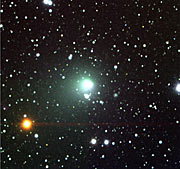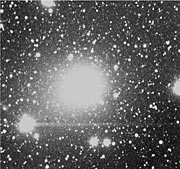Tisková zpráva
Comet Hale-Bopp - Still Enormous!
New Images from the New Technology Telescope at La Silla
29. června 1999
One of the most famous comets is Hale-Bopp that passed near the Earth just over two years ago. It now moves out through the solar system, getting fainter with increasing distance. The estimated magnitude is now about 12.5 (visual), i.e. about 400 times fainter than what can be perceived with the unaided eye.
Many observations of this object have been made with ESO telescopes during the past years. In August 1998, Methanol and Hydrogen Cyanide were detected in Hale-Bopp at record distance, cf. eso9810. The emissions from these molecules are now too faint to be measured, but other observations continue.
The most recent image of Comet Hale-Bopp was obtained at ESO on June 18, 1999, with the EMMI instrument at the ESO 3.5-m New Technology Telescope (NTT) at La Silla. This observation was somewhat difficult, as the comet was very low in the sky at the beginning of the twilight.
At that time, Comet Hale-Bopp was located in the southern constellation Dorado (The Goldfish). It was about 1295 million km (8.66 AU) distant from both the Earth and the Sun, i.e. at about as far away as planet Saturn.
The new NTT exposures have been combined to a (false) colour picture. It shows that there was still a substantial cloud of dust - a "coma" - around the comet's icy nucleus, even at this very large distance.
The second photodemonstrates the unusually large size of this coma. At the distance of the comet, the part that is visible in this photo is no less than 1.1 million km across, or nearly 10 times larger than Saturn! No other comets have ever been found to have such a large coma at this large distance [1].
There is now little structure in the coma and no "jets" are seen any more. Much of this coma consists of dust that was ejected from the nucleus when it was closer to the Sun. However, it is likely that dust is still lost from the nucleus into the coma, perhaps as a result of a continuing outflow of certain gases (in particular CO and CO 2 ), albeit at a lower level than before.
The maximum extent of the coma observed around Hale-Bopp when it was near the Earth and the Sun in early 1997, was 2-3 million km, or only a few times more than now; the uncertainty arises from the different observational methods used. Comae of other comets rarely ever become larger than a few hundred thousand kilometres. There is little doubt that the exceptional dimensions of the coma around Hale-Bopp is a direct consequence of its unusually large nucleus. Although it never became possible to measure its size accurately, a variety of observational methods points towards a diameter in the 40 - 70 km range. The nuclei of most other comets are at most a few km across. With its larger surface, more material is released - this provides a natural explanation of the unusual coma of Hale-Bopp .
Some years from now, this nucleus will be completely frozen. Then no more material will escape from the surface and the cloud will gradually disappear. It should then become possible, for the first time, to observe the "naked" nucleus of Hale-Bopp with large telescopes like the NTT and the Very Large Telescope (VLT) at Paranal.
More information is available at the dedicated ESO Hale-Bopp website.
Poznámky
[1] It appears that the largest coma seen before at another distant comet was that observed around Comet Halley after its perihelion passage. From very long exposures obtained at La Silla in April-May 1988, the diameter of its coma was found to be almost 500,000 km at a distance of about 1,300 million km (8.5 AU) from the Sun.
Addition on 5 July 1999: Kindly note that these observations were made with the EMMI multi-mode instrument at the NTT, not with SUSI2 as indicated in the original text of this release.
O zprávě
| Tiskové zpráva č.: | eso9933 |
| Legacy ID: | Photo 28a-b/99 |
| Jméno: | Comet Hale-Bopp |
| Typ: | Solar System Solar System : Interplanetary Body : Comet |
| Facility: | New Technology Telescope |
| Instruments: | EMMI |
Our use of Cookies
We use cookies that are essential for accessing our websites and using our services. We also use cookies to analyse, measure and improve our websites’ performance, to enable content sharing via social media and to display media content hosted on third-party platforms.
ESO Cookies Policy
The European Organisation for Astronomical Research in the Southern Hemisphere (ESO) is the pre-eminent intergovernmental science and technology organisation in astronomy. It carries out an ambitious programme focused on the design, construction and operation of powerful ground-based observing facilities for astronomy.
This Cookies Policy is intended to provide clarity by outlining the cookies used on the ESO public websites, their functions, the options you have for controlling them, and the ways you can contact us for additional details.
What are cookies?
Cookies are small pieces of data stored on your device by websites you visit. They serve various purposes, such as remembering login credentials and preferences and enhance your browsing experience.
Categories of cookies we use
Essential cookies (always active): These cookies are strictly necessary for the proper functioning of our website. Without these cookies, the website cannot operate correctly, and certain services, such as logging in or accessing secure areas, may not be available; because they are essential for the website’s operation, they cannot be disabled.
Functional Cookies: These cookies enhance your browsing experience by enabling additional features and personalization, such as remembering your preferences and settings. While not strictly necessary for the website to function, they improve usability and convenience; these cookies are only placed if you provide your consent.
Analytics cookies: These cookies collect information about how visitors interact with our website, such as which pages are visited most often and how users navigate the site. This data helps us improve website performance, optimize content, and enhance the user experience; these cookies are only placed if you provide your consent. We use the following analytics cookies.
Matomo Cookies:
This website uses Matomo (formerly Piwik), an open source software which enables the statistical analysis of website visits. Matomo uses cookies (text files) which are saved on your computer and which allow us to analyze how you use our website. The website user information generated by the cookies will only be saved on the servers of our IT Department. We use this information to analyze www.eso.org visits and to prepare reports on website activities. These data will not be disclosed to third parties.
On behalf of ESO, Matomo will use this information for the purpose of evaluating your use of the website, compiling reports on website activity and providing other services relating to website activity and internet usage.
Matomo cookies settings:
Additional Third-party cookies on ESO websites: some of our pages display content from external providers, e.g. YouTube.
Such third-party services are outside of ESO control and may, at any time, change their terms of service, use of cookies, etc.
YouTube: Some videos on the ESO website are embedded from ESO’s official YouTube channel. We have enabled YouTube’s privacy-enhanced mode, meaning that no cookies are set unless the user actively clicks on the video to play it. Additionally, in this mode, YouTube does not store any personally identifiable cookie data for embedded video playbacks. For more details, please refer to YouTube’s embedding videos information page.
Cookies can also be classified based on the following elements.
Regarding the domain, there are:
- First-party cookies, set by the website you are currently visiting. They are stored by the same domain that you are browsing and are used to enhance your experience on that site;
- Third-party cookies, set by a domain other than the one you are currently visiting.
As for their duration, cookies can be:
- Browser-session cookies, which are deleted when the user closes the browser;
- Stored cookies, which stay on the user's device for a predetermined period of time.
How to manage cookies
Cookie settings: You can modify your cookie choices for the ESO webpages at any time by clicking on the link Cookie settings at the bottom of any page.
In your browser: If you wish to delete cookies or instruct your browser to delete or block cookies by default, please visit the help pages of your browser:
Please be aware that if you delete or decline cookies, certain functionalities of our website may be not be available and your browsing experience may be affected.
You can set most browsers to prevent any cookies being placed on your device, but you may then have to manually adjust some preferences every time you visit a site/page. And some services and functionalities may not work properly at all (e.g. profile logging-in, shop check out).
Updates to the ESO Cookies Policy
The ESO Cookies Policy may be subject to future updates, which will be made available on this page.
Additional information
For any queries related to cookies, please contact: pdprATesoDOTorg.
As ESO public webpages are managed by our Department of Communication, your questions will be dealt with the support of the said Department.


